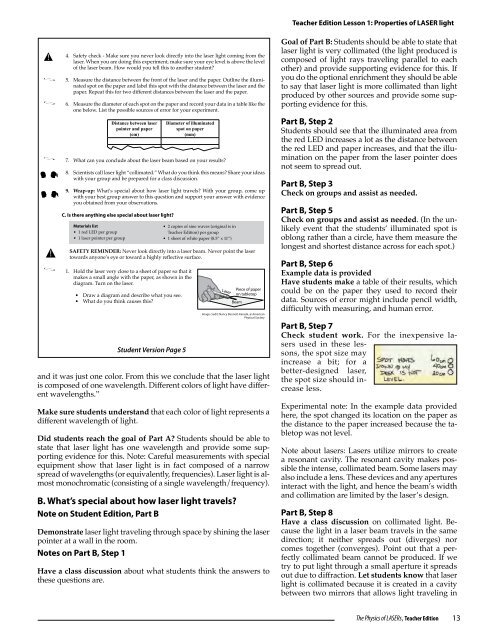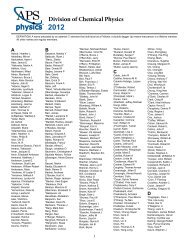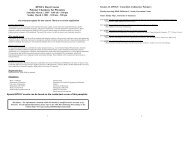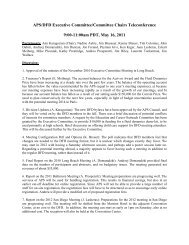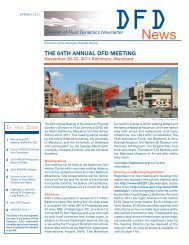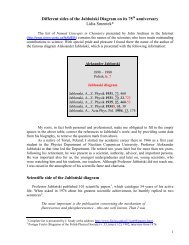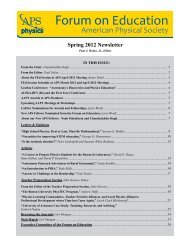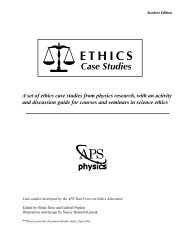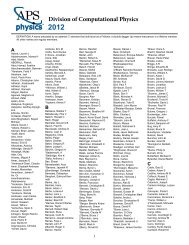The Physics of LASERs - American Physical Society
The Physics of LASERs - American Physical Society
The Physics of LASERs - American Physical Society
You also want an ePaper? Increase the reach of your titles
YUMPU automatically turns print PDFs into web optimized ePapers that Google loves.
!<br />
!<br />
Student Edition Lesson 1: Properties <strong>of</strong> LASER light<br />
4. Safety check - Make sure you never look directly into the laser light coming from the<br />
laser. When you are doing this experiment, make sure your eye level is above the level<br />
<strong>of</strong> the laser beam. How would you tell this to another student?<br />
5. Measure the distance between the front <strong>of</strong> the laser and the paper. Outline the illuminated<br />
spot on the paper and label this spot with the distance between the laser and the<br />
paper. Repeat this for two different distances between the laser and the paper.<br />
6. Measure the diameter <strong>of</strong> each spot on the paper and record your data in a table like the<br />
one below. List the possible sources <strong>of</strong> error for your experiment.<br />
Distance between laser<br />
pointer and paper<br />
(cm)<br />
Diameter <strong>of</strong> illuminated<br />
spot on paper<br />
(mm)<br />
7. What can you conclude about the laser beam based on your results?<br />
8. Scientists call laser light “collimated.” What do you think this means? Share your ideas<br />
with your group and be prepared for a class discussion.<br />
9. Wrap-up: What’s special about how laser light travels? With your group, come up<br />
with your best group answer to this question and support your answer with evidence<br />
you obtained from your observations.<br />
C. Is there anything else special about laser light?<br />
Materials list<br />
• 1 red LED per group<br />
• 1 laser pointer per group<br />
SAFETY REMINDER: Never look directly into a laser beam. Never point the laser<br />
towards anyone’s eye or toward a highly reflective surface.<br />
1. Hold the laser very close to a sheet <strong>of</strong> paper so that it<br />
makes a small angle with the paper, as shown in the<br />
diagram. Turn on the laser.<br />
• Draw a diagram and describe what you see.<br />
• What do you think causes this?<br />
Student Version Page 5<br />
• 2 copies <strong>of</strong> sine waves (original is in<br />
Teacher Edition) per group<br />
• 1 sheet <strong>of</strong> white paper (8.5” x 11”)<br />
Image credit: Nancy Bennett-Karasik, @ <strong>American</strong><br />
<strong>Physical</strong> <strong>Society</strong><br />
and it was just one color. From this we conclude that the laser light<br />
is composed <strong>of</strong> one wavelength. Different colors <strong>of</strong> light have different<br />
wavelengths.”<br />
Make sure students understand that each color <strong>of</strong> light represents a<br />
different wavelength <strong>of</strong> light.<br />
Did students reach the goal <strong>of</strong> Part A? Students should be able to<br />
state that laser light has one wavelength and provide some supporting<br />
evidence for this. Note: Careful measurements with special<br />
equipment show that laser light is in fact composed <strong>of</strong> a narrow<br />
spread <strong>of</strong> wavelengths (or equivalently, frequencies). Laser light is almost<br />
monochromatic (consisting <strong>of</strong> a single wavelength/frequency).<br />
B. What’s special about how laser light travels?<br />
Note on Student Edition, Part B<br />
<strong>The</strong> <strong>Physics</strong> <strong>of</strong> <strong>LASERs</strong><br />
Demonstrate laser light traveling through space by shining the laser<br />
pointer at a wall in the room.<br />
Notes on Part B, Step 1<br />
Have a class discussion about what students think the answers to<br />
these questions are.<br />
5<br />
Teacher Edition Lesson 1: Properties <strong>of</strong> LASER light<br />
Goal <strong>of</strong> Part B: Students should be able to state that<br />
laser light is very collimated (the light produced is<br />
composed <strong>of</strong> light rays traveling parallel to each<br />
other) and provide supporting evidence for this. If<br />
you do the optional enrichment they should be able<br />
to say that laser light is more collimated than light<br />
produced by other sources and provide some supporting<br />
evidence for this.<br />
Part B, Step 2<br />
Students should see that the illuminated area from<br />
the red LED increases a lot as the distance between<br />
the red LED and paper increases, and that the illumination<br />
on the paper from the laser pointer does<br />
not seem to spread out.<br />
Part B, Step 3<br />
Check on groups and assist as needed.<br />
Part B, Step 5<br />
Check on groups and assist as needed. (In the unlikely<br />
event that the students’ illuminated spot is<br />
oblong rather than a circle, have them measure the<br />
longest and shortest distance across for each spot.)<br />
Part B, Step 6<br />
Example data is provided<br />
Have students make a table <strong>of</strong> their results, which<br />
could be on the paper they used to record their<br />
data. Sources <strong>of</strong> error might include pencil width,<br />
difficulty with measuring, and human error.<br />
Part B, Step 7<br />
Check student work. For the inexpensive lasers<br />
used in these lessons,<br />
the spot size may<br />
increase a bit; for a<br />
better-designed laser,<br />
the spot size should increase<br />
less.<br />
Experimental note: In the example data provided<br />
here, the spot changed its location on the paper as<br />
the distance to the paper increased because the tabletop<br />
was not level.<br />
Note about lasers: Lasers utilize mirrors to create<br />
a resonant cavity. <strong>The</strong> resonant cavity makes possible<br />
the intense, collimated beam. Some lasers may<br />
also include a lens. <strong>The</strong>se devices and any apertures<br />
interact with the light, and hence the beam’s width<br />
and collimation are limited by the laser’s design.<br />
Part B, Step 8<br />
Have a class discussion on collimated light. Because<br />
the light in a laser beam travels in the same<br />
direction; it neither spreads out (diverges) nor<br />
comes together (converges). Point out that a perfectly<br />
collimated beam cannot be produced. If we<br />
try to put light through a small aperture it spreads<br />
out due to diffraction. Let students know that laser<br />
light is collimated because it is created in a cavity<br />
between two mirrors that allows light traveling in<br />
<strong>The</strong> <strong>Physics</strong> <strong>of</strong> <strong>LASERs</strong>, Teacher Edition<br />
13


